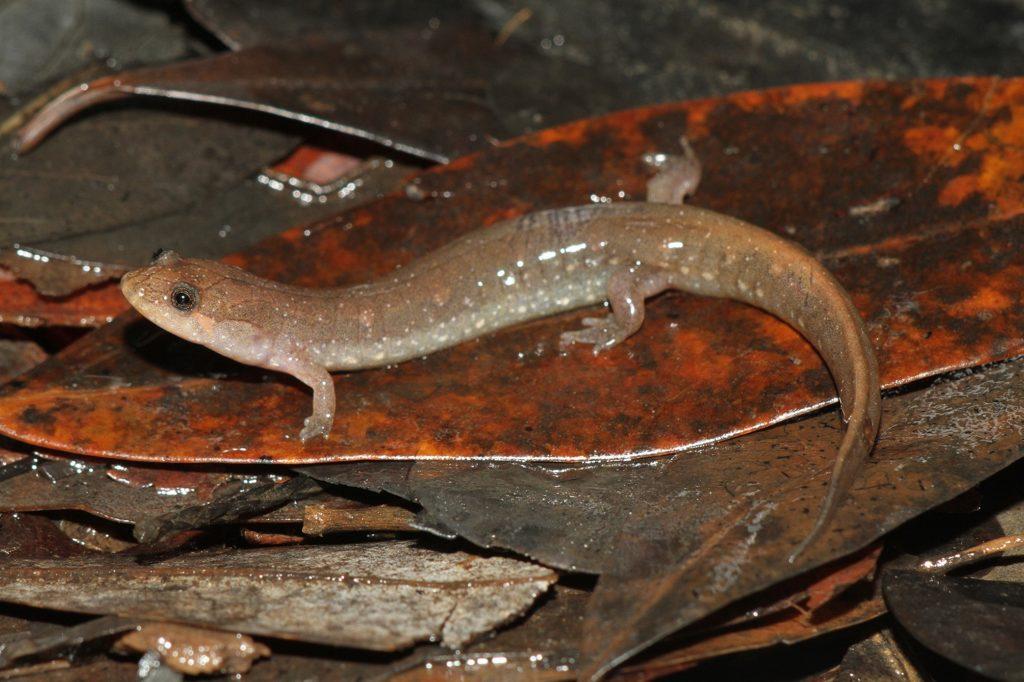In 2008, David Beamer, a biology instructor at a North Carolina community college, trekked through the muddy swamps of the Gulf Coastal Plain to document a potentially new species of swamp-dwelling salamander.
Now 14 years later, Beamer has co-authored a study released earlier this month with R. Alexander Pyron, an associate professor of biology in the Columbian College of Arts and Sciences, that used genetic data to introduce Desmognathus pascagoula as a new salamander species. Pyron said Desmognathus pascagoula is the first of more than 20 new salamander species that his team has discovered using genetic data in their fieldwork in the eastern United States, which they will release in similar papers.
Pyron said he has studied dusky salamanders in the eastern United States since 2010, now leading a team of researchers investigating the animal. Biologists and researchers mistakenly referred to Desmognathus pascagoula specimens as D. auriculatus or D. valentinei, other species of swamp-dwelling dusky salamanders, in the past before Pyron’s team identified them as genetically and physically distinct.
Desmognathus pascagoula is smaller than other dusky salamanders, which range from just under an inch to about 7 inches in length and are distinguishable by their lateral white spots, according to the study. Pyron said Desmognathus pascagoula’s brown color and small size make them difficult to find and identify in the muddy swamps where they live.
Pyron said he and his researchers would wade through swamps looking for specimens of the new species in the mud under leaves and logs to take genetic samples and compare their DNA with other salamanders. Pyron said finding two or three specimens could take days or weeks.
“We’re up to our waists in just thick mud, and we’re basically just trying to rake through the mud and see if we see a tiny little brown salamander wriggling away” Pyron said.
He said his research team received a grant from the National Science Foundation in 2017 to use DNA sequencing data to identify how potential new species differed from others, which helped lead to their new species discoveries.
Pyron said the new species could have easily gone undiscovered by researchers for years, noting that they were found where scientists had already been exploring for centuries in the eastern United States.
“The biodiversity of the planet is extremely underestimated and poorly known,” he said.
Pyron said discovering new species reveals new information about its ecosystems, allowing for a deeper understanding of the ecology of a region. He said alpha taxonomy – the discipline of discovering new species – is the “fundamental building block” for understanding evolution and ecology and striving to protect the environment.
Researchers consider the Gulf Coastal Plain a biodiversity hotspot, a term coined to designate regions with significant amounts of unique species that are threatened by human activity. Pyron said the region’s classification as a biodiversity hotspot, which researchers in the field decide based on criteria for the amount of unique species and human impact on the region, would bring more recognition from the public to the region’s distinctive plants and animals.
“It’s underappreciated in terms of recognizing the biodiversity that’s there and really acknowledging the distinctiveness of the region in terms of its flora and fauna,” he said.
Pyron said his team plans to continue releasing similar studies about the new species of dusky salamanders they have identified before studying their evolution in depth.
Beamer said identifying new species and their habitats is key for preserving the habitats of endemic species – a plant or animal species native only to a specific area – like Desmognathus pascagoula.
“It’s easy to lose a species if its range is very small,” he said. “So hopefully there’ll be more interest now that we understand that this species is different and unique and that we understand that it has a relatively small range.”
Beamer said identifying new species can also aid the development of medicine and pharmaceuticals, which often derive ingredients from living organisms. He said salamanders have been subject to studies aiming to find a human application of their unique capability as the only vertebrates that can regrow complex tissue, like limbs and even their brains.
He said increased knowledge of the southeastern United States Coastal Plain’s biodiversity would raise awareness about the need to protect the region’s environment.
“Once you start talking about something in a way that makes people understand that it’s different, that it’s special,” Beamer said. “That’s what alerts people to be like, ‘Oh, well, maybe I should care about that.’”
Jessica Lamb, an assistant professor of biology at St. Cloud State University and co-author of the study, discovered a Desmognathus pascagoula salamander before working on the study while she was a doctoral student, finding that its DNA differed from other dusky salamanders. She said Pyron and Beamer reached out to collaborate with her on the study due to this documentation of genetic data that matched the Desmognathus pascagoula specimens they were studying in the years prior.
She said the Pascagoula River in Mississippi, where Desmognathus pascagoula can be found, has a high rate of species diversity as one of the largest undammed rivers in the United States. Lamb said conservationists should focus efforts around habitat conservation because of this connection.
Lamb said biologists could research Desmognathus pascagoula’s natural history, like egg-laying behaviors, larval periods and courtship rituals now that they have discovered the species
“What I’m more interested in is figuring out those other pieces of the Pascagoula dusky puzzle,” she said.








